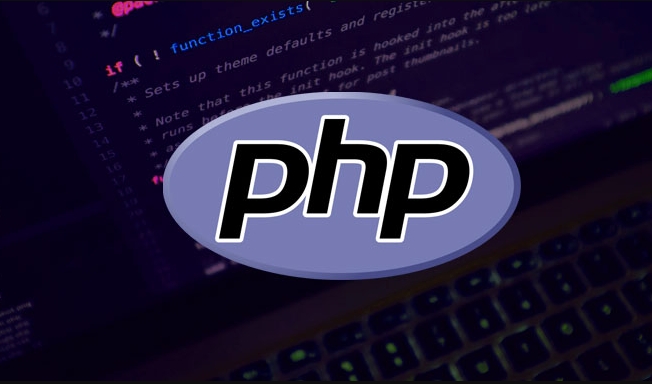In PHP regular expressions, use ^ and $ anchors to match the beginning and end of a string respectively. 1. ^ means the beginning of the string, ensuring that the matching content appears from the beginning, such as /^hello/, verify whether it starts with hello; 2. $ means the end of the string, such as /.jpg$/, verify whether it ends with .jpg; 3. Use ^ and $ in combination to achieve a complete match, such as /^abc\d $/ to ensure that the entire string conforms to the specified format; 4. In multi-line mode, ^ and $ will match the beginning and end of each line respectively; 5. Note that the ending line breaks may affect the matching result, and you can use \s* or trim() to avoid problems. Mastering these details can improve the accuracy of regular expressions.

In PHP regular expressions, if you want to match a pattern that must appear at the beginning or end of a string, you need to use the "first line" and "first line" anchors. These anchors themselves do not match any characters, but rather indicate positions. Understanding how they are used will allow you to write more accurate regular expressions.

^ indicates the beginning of the string
This symbol is used to ensure that the matching content appears from the beginning of the string. For example, if you want to determine whether a string starts with "hello":

if (preg_match('/^hello/', $string)) {
// Match successfully}As long as “hello” is not the first word to appear, it will not match.
Note: If you enable multi-line mode (add the
mmodifier),^will also match the beginning of each line.
Common uses:
- Verify that the input starts with a specific content
- Extract data with fixed format prefixes
$ means the end of the string
Similar to ^ , $ is another anchor point that matches the end position of the string. For example, you want to confirm whether a string ends in .jpg :
if (preg_match('/\.jpg$/', $filename)) {
// It's a picture file} If the file name is photo.jpg.zip , it does not match; if it is photo.jpg , it does not match.
Similarly, in multi-line mode,
$will also match the end of each line.
Combination: Completely match the entire string
When you need to exactly match a string, you can use ^ and $ to limit the entire structure:
if (preg_match('/^abc\d $/', $input)) {
// The input must be abc followed by one or more numbers} This can prevent partial matching situations like xabc123y . This writing method is very useful when verifying user input.
To give a few common examples:
- Email format verification (although it cannot be completely based on regularity)
- Fixed length number, password format requirements
- URL path rule matching (such as
/user/\d)
Note: End line breaks may also affect the results
Sometimes when you are working on text, the ending may have a newline character \n or \r\n . If you use the $ anchor point but do not add the modifier D , it will still think that $ is preceded by the end of the string, not the newline.
One solution is to add \s* to the end to ignore the blank, or use trim() to process the string before making a match.
Basically that's it. Mastering the use of ^ and $ can help you avoid many mismatch problems. Although it may seem simple, details are easily overlooked in practical applications, especially when dealing with user input or complex formats.
The above is the detailed content of php regex start of string and end of string anchors. For more information, please follow other related articles on the PHP Chinese website!

Hot AI Tools

Undress AI Tool
Undress images for free

Undresser.AI Undress
AI-powered app for creating realistic nude photos

AI Clothes Remover
Online AI tool for removing clothes from photos.

Clothoff.io
AI clothes remover

Video Face Swap
Swap faces in any video effortlessly with our completely free AI face swap tool!

Hot Article

Hot Tools

Notepad++7.3.1
Easy-to-use and free code editor

SublimeText3 Chinese version
Chinese version, very easy to use

Zend Studio 13.0.1
Powerful PHP integrated development environment

Dreamweaver CS6
Visual web development tools

SublimeText3 Mac version
God-level code editing software (SublimeText3)
 PHP Variable Scope Explained
Jul 17, 2025 am 04:16 AM
PHP Variable Scope Explained
Jul 17, 2025 am 04:16 AM
Common problems and solutions for PHP variable scope include: 1. The global variable cannot be accessed within the function, and it needs to be passed in using the global keyword or parameter; 2. The static variable is declared with static, and it is only initialized once and the value is maintained between multiple calls; 3. Hyperglobal variables such as $_GET and $_POST can be used directly in any scope, but you need to pay attention to safe filtering; 4. Anonymous functions need to introduce parent scope variables through the use keyword, and when modifying external variables, you need to pass a reference. Mastering these rules can help avoid errors and improve code stability.
 How to handle File Uploads securely in PHP?
Jul 08, 2025 am 02:37 AM
How to handle File Uploads securely in PHP?
Jul 08, 2025 am 02:37 AM
To safely handle PHP file uploads, you need to verify the source and type, control the file name and path, set server restrictions, and process media files twice. 1. Verify the upload source to prevent CSRF through token and detect the real MIME type through finfo_file using whitelist control; 2. Rename the file to a random string and determine the extension to store it in a non-Web directory according to the detection type; 3. PHP configuration limits the upload size and temporary directory Nginx/Apache prohibits access to the upload directory; 4. The GD library resaves the pictures to clear potential malicious data.
 Commenting Out Code in PHP
Jul 18, 2025 am 04:57 AM
Commenting Out Code in PHP
Jul 18, 2025 am 04:57 AM
There are three common methods for PHP comment code: 1. Use // or # to block one line of code, and it is recommended to use //; 2. Use /.../ to wrap code blocks with multiple lines, which cannot be nested but can be crossed; 3. Combination skills comments such as using /if(){}/ to control logic blocks, or to improve efficiency with editor shortcut keys, you should pay attention to closing symbols and avoid nesting when using them.
 How Do Generators Work in PHP?
Jul 11, 2025 am 03:12 AM
How Do Generators Work in PHP?
Jul 11, 2025 am 03:12 AM
AgeneratorinPHPisamemory-efficientwaytoiterateoverlargedatasetsbyyieldingvaluesoneatatimeinsteadofreturningthemallatonce.1.Generatorsusetheyieldkeywordtoproducevaluesondemand,reducingmemoryusage.2.Theyareusefulforhandlingbigloops,readinglargefiles,or
 Tips for Writing PHP Comments
Jul 18, 2025 am 04:51 AM
Tips for Writing PHP Comments
Jul 18, 2025 am 04:51 AM
The key to writing PHP comments is to clarify the purpose and specifications. Comments should explain "why" rather than "what was done", avoiding redundancy or too simplicity. 1. Use a unified format, such as docblock (/*/) for class and method descriptions to improve readability and tool compatibility; 2. Emphasize the reasons behind the logic, such as why JS jumps need to be output manually; 3. Add an overview description before complex code, describe the process in steps, and help understand the overall idea; 4. Use TODO and FIXME rationally to mark to-do items and problems to facilitate subsequent tracking and collaboration. Good annotations can reduce communication costs and improve code maintenance efficiency.
 Quick PHP Installation Tutorial
Jul 18, 2025 am 04:52 AM
Quick PHP Installation Tutorial
Jul 18, 2025 am 04:52 AM
ToinstallPHPquickly,useXAMPPonWindowsorHomebrewonmacOS.1.OnWindows,downloadandinstallXAMPP,selectcomponents,startApache,andplacefilesinhtdocs.2.Alternatively,manuallyinstallPHPfromphp.netandsetupaserverlikeApache.3.OnmacOS,installHomebrew,thenrun'bre
 How to access a character in a string by index in PHP
Jul 12, 2025 am 03:15 AM
How to access a character in a string by index in PHP
Jul 12, 2025 am 03:15 AM
In PHP, you can use square brackets or curly braces to obtain string specific index characters, but square brackets are recommended; the index starts from 0, and the access outside the range returns a null value and cannot be assigned a value; mb_substr is required to handle multi-byte characters. For example: $str="hello";echo$str[0]; output h; and Chinese characters such as mb_substr($str,1,1) need to obtain the correct result; in actual applications, the length of the string should be checked before looping, dynamic strings need to be verified for validity, and multilingual projects recommend using multi-byte security functions uniformly.
 Learning PHP: A Beginner's Guide
Jul 18, 2025 am 04:54 AM
Learning PHP: A Beginner's Guide
Jul 18, 2025 am 04:54 AM
TolearnPHPeffectively,startbysettingupalocalserverenvironmentusingtoolslikeXAMPPandacodeeditorlikeVSCode.1)InstallXAMPPforApache,MySQL,andPHP.2)Useacodeeditorforsyntaxsupport.3)TestyoursetupwithasimplePHPfile.Next,learnPHPbasicsincludingvariables,ech







